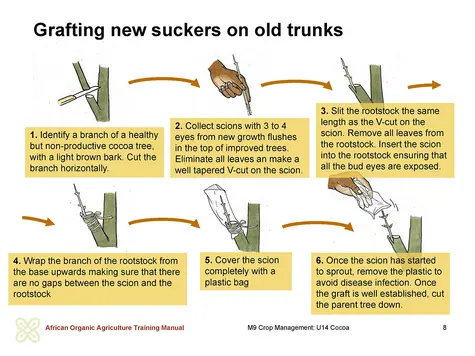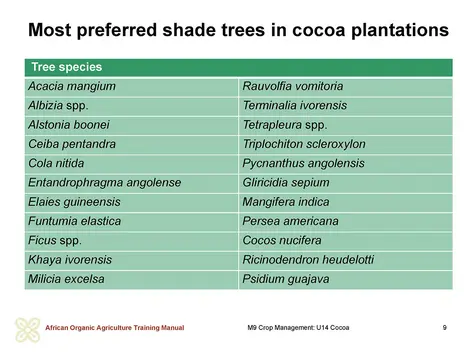Improving existing cocoa plantations into agroforestry systems
The lifecycle of a cocoa tree can span well over 100 years. Even already existing cocoa plantations can be converted into a dynamic agroforestry system to improve the cocoa yields. The best approach, however, will depend primarily on the current status of the plantation. The following points with recommendations are given:
a. Mature but unproductive trees under shade trees:
- Identify all the unproductive cocoa trees. Cut some completely down, while adjoining ones should be heavily pruned.
- Prune back all the shade trees in the sphere of influence of the cut trees to the remaining crown. Shred the prunings and disperse them evenly on the ground.
- Plant new cocoa seedlings into the gaps. If the area is big enough, pioneer plants such as maize and rice may be planted. In this case, it is better to use seedlings prepared in the nursery than sowing seeds.
- This procedure builds an ‘agroforestry island’ in the plantation. Several of such ‘islands’ will have a positive effect on the growing conditions in the entire plantation.
b. Old but still productive plantations with shade trees of the secondary forest system:
As long as such plantations are of good productivity and do not have pest or disease problems, no major interventions are necessary. Such plantations can be converted to organic production just by abandoning the use of synthetic inputs and by correctly carrying out all maintenance operations.
c. Old unproductive plantations and plantations prone to diseases, with shade trees:
Plantations which used to be productive and now display problems such as poor productivity, and pest and disease infestations, should be rejuvenated entirely.
- Completely remove any existing trees which are pest and disease-prone or of low productivity, and replace them. Or rejuvenate them by grafting with new suckers.
- Plant the bananas, the pioneer plants and the entire tree species of the various storeys before the old shade trees are felled.
- If possible, leave the plant material resulting from felled trees in the plantation.
- Coppice the cocoa trees to a height of about 40 cm.
- Chop, shred and spread all the branches on the ground.
- Correct the spacing between the old cocoa trees, if needed.
- Select one sucker growing from the coppiced cocoa trees that shall produce fruits after about 3 years and remove all other suckers.
d. Still productive plantations without shade trees:
Many plantations have been established without any shade, or the shade trees have been removed over time. Improvement of such plantations should begin with the establishment of shade trees. This can be achieved by introducing ‘agroforestry islands’. Depending on the age of the plantation, the cocoa trees will be pruned, coppiced or completely rejuvenated from suckers.
Another common way to renew a plantation is to graft the new suckers. Here only suckers which can form their own root system are selected. This is especially carried out in order to introduce new varieties into the farming system. The grafting for a new crown structure can also be made directly in the trunk, where it is possible to graft various cocoa cultivars on the same rootstock.
e. Low productive plantations with a high cocoa tree density and few shade trees trees:
Many cocoa farms in West Africa are over 40 years old and produce low yields mainly due to the age of the trees and poor maintenance. If cocoa trees have several trunks, which grow in competition without forming a real canopy, it would be necessary to rehabilitate the plantation as described in (c). Cocoa trees ideally have one stem and only 3 to 5 main branches, with enough side branches and leaves to capture most of the sunlight.
f. Low productive plantations with a high cocoa tree density without shade trees on depleted soils trees:
Most of the West African cocoa plantations consist of weak cocoa trees that grow on depleted soils with a very low content of organic matter. Many farmers replant cocoa on the same site between the rows of the old cocoa trees. But there are no results to be expected without implementation of measures that improve soil fertility. Improvement of soil fertility can be achieved by reestablishing a high production of organic matter growing robust native legume herbs and bushes.


 tap and then scroll down to the Add to Home Screen command.
tap and then scroll down to the Add to Home Screen command.